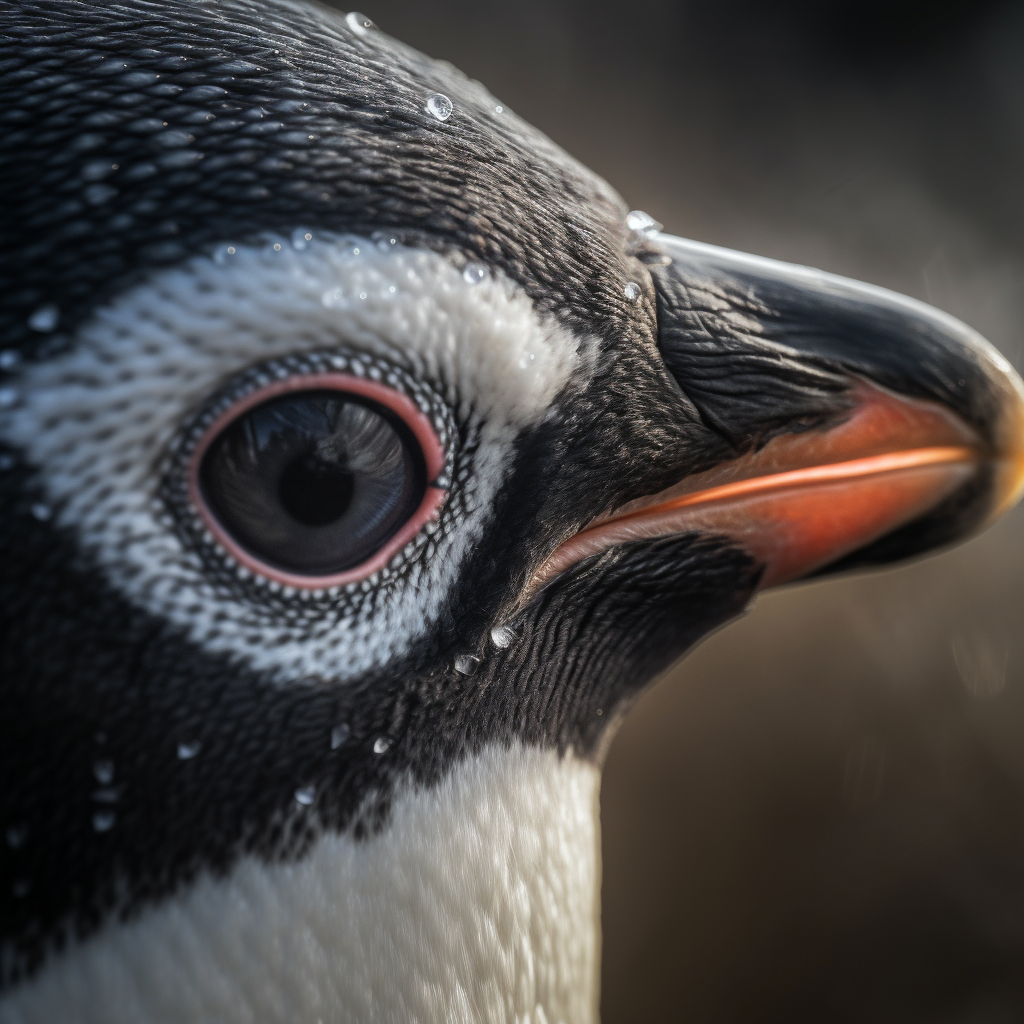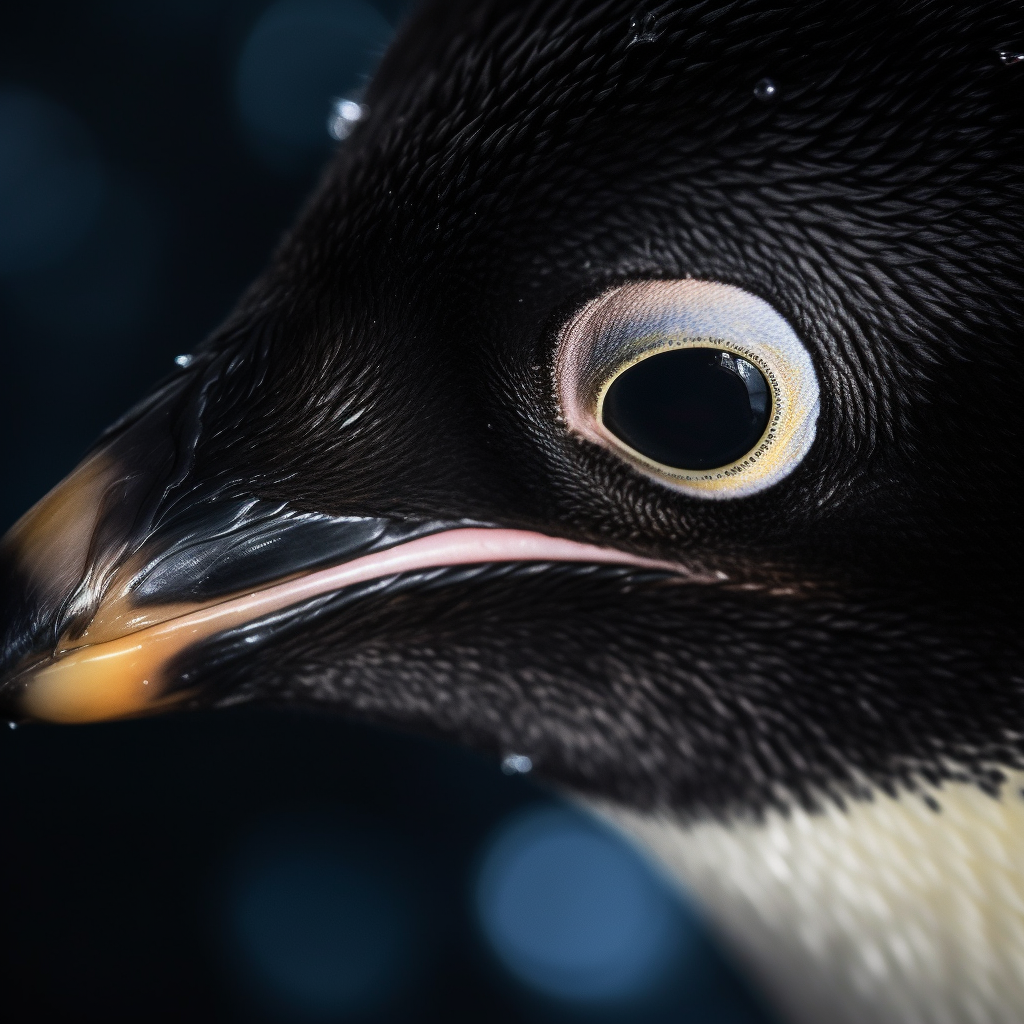Penguins are fascinating creatures that have adapted to life in the harsh conditions of the Antarctic. While they may not have external ears like many other animals, they do possess a unique auditory system that allows them to navigate their environment and communicate with one another. In this article, we will explore the intriguing world of penguin ears, delving into their anatomy, function, and the remarkable adaptations that enable these flightless birds to thrive in their icy habitat. So, let’s dive in and discover the secrets of penguin ears!
Key Takeaways
- Penguins do not have external ears like most other birds.
- Instead, penguins have small openings on the sides of their heads that lead to their inner ears.
- These openings are covered by feathers and help protect the penguins’ ears from cold water and wind.
- Penguins rely heavily on their hearing for communication and navigation underwater.
- The unique ear structure of penguins allows them to hear both in air and underwater.
The Mystery of Penguin Ears

A. Do Penguins Have Ears?
When we think of animals with ears, penguins might not be the first creatures that come to mind. After all, these flightless birds have a streamlined appearance and spend most of their lives in the water. But do penguins have ears? The answer is yes, but their ears are quite different from ours.
Unlike humans and many other animals, penguins do not have external ears that stick out from their heads. Instead, their ears are located on the sides of their heads, hidden beneath their feathers. This unique adaptation helps protect their ears from the cold Antarctic waters and reduces drag while swimming.
B. Where Are Penguins’ Ears Located?
Penguins’ ears are located just behind their eyes, on the sides of their heads. Although they are not visible to the naked eye, they are still functional and play an important role in the penguins’ lives.
C. What Do Penguins’ Ears Look Like?
While we can’t see penguins’ ears, we can imagine what they might look like based on their anatomy. Penguins’ ears are small openings covered by feathers, which help to keep water out. These openings are connected to the penguins’ ear canals, which lead to the middle and inner ear.
D. Facts About Penguins’ Ears
Here are some interesting facts about penguins’ ears:
-
Hearing Underwater: Penguins’ ears are adapted to hear sounds both in the air and underwater. They have a specialized structure that allows them to detect and interpret sounds in their aquatic environment.
-
Sensitive to Frequencies: Penguins’ ears are particularly sensitive to low-frequency sounds, which are important for communication and detecting prey underwater. This sensitivity helps them navigate and locate food in their marine habitat.
-
Parent-Chick Communication: Penguins use their ears to communicate with their chicks. Adult penguins produce unique vocalizations that their chicks can recognize, helping them locate their parents in crowded colonies.
-
Hearing in Noisy Environments: Penguins’ ears are designed to filter out background noise, allowing them to focus on important sounds. This adaptation is crucial in their noisy breeding colonies, where thousands of penguins gather to nest and raise their young.
-
Adaptations for Diving: When penguins dive underwater, their ears automatically close to prevent water from entering. This protective mechanism ensures that their ears remain dry and functional, even during their deep dives in search of food.
In conclusion, while penguins’ ears may not be as visible as ours, they play a vital role in their survival and communication. These unique adaptations allow penguins to thrive in their aquatic environment and navigate the challenges of their icy world. So, the next time you see a penguin waddling on the ice or swimming gracefully in the water, remember that they have ears too, even if they are hidden beneath their feathers.
The Functionality of Penguin Ears

A. Do Penguins Have Good Hearing?
When we think of penguins, we often picture them waddling on the ice or swimming gracefully through the water. But have you ever wondered about their hearing abilities? Penguins may not have external ears like we do, but they have a remarkable sense of hearing that helps them navigate their environment and communicate with each other.
While penguins don’t have visible ears, their hearing organs are located inside their heads. These organs are similar to our own inner ears and are responsible for detecting and processing sound waves. Despite not having external ears, penguins have excellent hearing capabilities that allow them to perceive sounds both above and below the water.
Penguins rely on their hearing to locate their chicks, find their way back to their nesting sites, and communicate with other members of their colony. Their ability to hear is particularly important during the breeding season when parents need to locate their chicks among thousands of other penguins.
B. The Role of Ears in Penguins’ Orientation
Penguins use their hearing abilities to orient themselves in their environment. When they are underwater, they can detect the sounds of their fellow penguins, which helps them stay together in a group. This is especially crucial when they are hunting for food or avoiding predators.
Additionally, penguins use their hearing to navigate through the water. They can perceive the sounds of waves and currents, allowing them to adjust their swimming patterns accordingly. This helps them conserve energy and move efficiently through their aquatic habitat.
Above the water, penguins rely on their hearing to communicate with each other. They produce a variety of vocalizations, including calls and songs, which can be heard by other members of their colony. These vocalizations serve as a form of communication, allowing penguins to establish territories, attract mates, and coordinate their activities.
C. Why Don’t Penguins Have External Ears?
You might be wondering why penguins don’t have external ears like many other animals. The absence of external ears in penguins is actually an adaptation to their aquatic lifestyle. External ears could easily be damaged or hindered by the water pressure and the icy conditions in which penguins live.
Instead of external ears, penguins have a small opening on each side of their head, known as the ear canal. This opening leads to their internal ear structures, allowing sound waves to enter and be processed. The lack of external ears also helps penguins streamline their bodies, reducing drag as they swim through the water.
In addition to their hearing abilities, penguins have other remarkable adaptations that enable them to thrive in their unique environment. From their waterproof feathers to their specialized beaks and flippers, penguins are well-equipped for life in the Antarctic and other cold regions.
In conclusion, while penguins may not have external ears, their internal hearing organs play a vital role in their survival. Their ability to hear helps them navigate, communicate, and locate their chicks in the vast and sometimes harsh Antarctic landscape. So, the next time you see a penguin, remember that behind those adorable faces lies a remarkable sense of hearing that allows them to thrive in their icy world.
The Curious Case of Fluffy and Hairy Penguin Ears
Penguins are fascinating creatures that have captured the hearts of many with their adorable waddle and distinctive appearance. While we often associate penguins with their sleek bodies and tuxedo-like feathers, there is one aspect of their anatomy that often goes unnoticed – their ears.
A. Penguins with Fluffy Ears: Myth or Reality?
When we think of penguins, we typically envision them with smooth, streamlined heads, devoid of any visible ears. However, there is a common misconception that penguins have fluffy ears hidden beneath their feathers. So, do penguins really have fluffy ears?
The truth is, penguins do not have external ears like humans or many other animals. Instead, their ears are located beneath the feathers, making them virtually invisible. This adaptation helps penguins maintain their hydrodynamic shape, allowing them to glide effortlessly through the water.
While penguins may not have fluffy ears, they do have excellent hearing capabilities. Their ears are specially designed to pick up sounds both above and below the water’s surface. This is crucial for their survival, as penguins rely on their hearing to locate prey, communicate with their mates, and navigate their surroundings.
B. Penguins with Hairy Ears: An Interesting Observation
While penguins may not have fluffy ears, there is an interesting observation regarding their ear feathers. Some penguin species, such as the Emperor penguin, have been found to have long, hair-like feathers surrounding their ear openings. These feathers, known as auricular feathers, serve a unique purpose.
The auricular feathers help to protect the penguin’s delicate ear openings from the harsh Antarctic elements. They act as insulation, preventing snow and ice from entering the ears and potentially causing damage. Additionally, these feathers may also help to enhance the penguin’s hearing abilities by directing sound towards the ear openings.
It’s important to note that not all penguin species have these auricular feathers. The presence or absence of these feathers can vary among different species and even within individuals of the same species. This variation highlights the incredible adaptability and diversity of penguins.
C. Penguin Ears Hat: A Cute Representation
The image of a penguin wearing a cute hat with ear flaps is a popular representation in cartoons and merchandise. While it may be adorable, it is important to remember that penguins do not actually wear hats or have external ears.
The portrayal of penguins with hats is purely fictional and serves as a whimsical way to anthropomorphize these beloved creatures. It allows us to connect with them on a more relatable level, even though their actual anatomy is quite different from ours.
In conclusion, while penguins may not have fluffy or hairy ears, their hearing abilities are crucial for their survival in the Antarctic environment. Their hidden ears, combined with their exceptional hearing, allow them to navigate the icy waters, communicate with their mates, and locate prey. So, the next time you admire a penguin, take a moment to appreciate the incredible adaptations that make them such remarkable creatures.
Penguins’ Behavior and Its Relation to Their Ears
A. Why Do Penguins Look Up?
Have you ever wondered why penguins often tilt their heads upwards, as if they’re gazing at the sky? It turns out that this behavior is closely related to their remarkable ears. While penguins may not have external ears like we do, they possess a unique auditory system that allows them to hear sounds both above and below the water’s surface.
Penguins spend a significant amount of their lives in the water, where they rely on their hearing to navigate and communicate with their fellow penguins. By looking up, they can better position their ear canals to capture sounds from above. This is especially important when they are hunting for food or trying to locate their mates in a crowded colony.
B. When Penguins Turn: Is It Related to Their Hearing?
If you’ve ever observed penguins, you may have noticed that they often turn their heads from side to side. This behavior is not just a random movement; it is directly linked to their hearing abilities. By turning their heads, penguins can pinpoint the direction of a sound more accurately.
Penguins have a remarkable ability to localize sounds, thanks to the structure of their ears. While their ears may not be visible, they have a specialized auditory system that allows them to detect the subtle differences in sound intensity and timing between their left and right ears. This enables them to determine the direction from which a sound is coming, whether it’s the call of a nearby penguin or the splash of a potential predator in the water.
C. Why Do Penguins Just Stand Around?
You may have noticed that penguins often spend a considerable amount of time standing still, seemingly doing nothing. But don’t be fooled by their seemingly idle behavior. Penguins are actually engaged in important activities that are closely tied to their hearing.
One reason penguins stand around is to communicate with each other. Penguins have a wide range of vocalizations that they use to convey messages to their mates, chicks, and other members of their colony. By standing still, they can better focus on listening to the calls of their fellow penguins and respond accordingly.
Additionally, standing still allows penguins to conserve energy. Penguins are well-adapted to their cold Antarctic environment, but they still need to conserve energy to survive. By minimizing unnecessary movements, they can maintain their body heat and conserve energy for activities like hunting for food or caring for their chicks.
In conclusion, penguins’ behavior is closely linked to their remarkable ears. By looking up, turning their heads, and standing still, penguins can make the most of their auditory abilities. These behaviors help them navigate their environment, communicate with each other, and ultimately survive in their unique and challenging habitat. So, the next time you see a penguin tilting its head or standing still, remember that there’s more to their behavior than meets the eye.
Penguins’ Diet and Its Impact on Their Hearing

A. What Do Penguins Eat?
Penguins are known for their unique diet, which primarily consists of fish and other marine creatures. However, the specific types of fish they consume can vary depending on the species and their habitat. Some penguins primarily feed on small fish like anchovies and sardines, while others may target larger prey such as squid and krill.
In addition to fish, penguins also consume crustaceans like shrimp and krill, as well as small cephalopods like squid. These diverse food sources provide the necessary nutrients for penguins to thrive in their harsh Antarctic environment.
B. What Fish Do Penguins Eat?
Different penguin species have different preferences when it comes to their fishy meals. For example, the Adélie penguin, which is one of the most common penguin species in Antarctica, primarily feeds on Antarctic krill. These small, shrimp-like crustaceans are abundant in the Southern Ocean and serve as a vital food source for Adélie penguins.
Emperor penguins, on the other hand, have a more varied diet. They primarily feed on fish such as Antarctic silverfish and lanternfish, which are found in the icy waters of the Southern Ocean. These fish provide the emperor penguins with the necessary energy to survive in the extreme cold.
Chinstrap penguins, another species commonly found in the Antarctic region, have a diet that consists mainly of Antarctic krill and small fish like Antarctic silverfish. These penguins are known for their agility in the water, allowing them to catch their prey with ease.
C. Does Diet Influence Penguins’ Hearing Abilities?
The diet of penguins plays a crucial role in their overall health and well-being, including their hearing abilities. While penguins don’t have external ears like humans do, they have a highly developed auditory system that allows them to detect and locate sounds underwater.
The specific nutrients found in the fish and other marine creatures that penguins consume can have a direct impact on their hearing abilities. Omega-3 fatty acids, for example, are essential for maintaining healthy auditory function. These fatty acids are abundant in fish and are known to support the development and maintenance of the sensory cells in the inner ear.
Furthermore, a balanced diet rich in vitamins and minerals is crucial for overall health, including the health of the auditory system. Adequate nutrition ensures that the penguins’ hearing organs, such as the cochlea, function optimally, allowing them to perceive sounds accurately.
In conclusion, the diet of penguins has a significant impact on their hearing abilities. By consuming a variety of fish and other marine creatures, penguins can obtain the necessary nutrients to support their auditory system. This enables them to navigate their underwater world and communicate with other penguins effectively.
The Symbolism of Penguin Ears
A. Penguin Icon Meaning: The Role of Ears
When we think of penguins, we often picture these adorable creatures waddling on the ice, their distinctive black and white feathers standing out against the stark Antarctic landscape. But have you ever wondered about the significance of their ears? While penguins do have ears, they are not as visible as those of other animals. In fact, their ears are hidden beneath their feathers, making them almost invisible to the naked eye.
So, what is the role of ears in the life of a penguin? While penguins may not rely heavily on their sense of hearing like some other animals do, their ears serve important functions in their daily lives. Let’s explore the fascinating world of penguin ears and uncover their hidden symbolism.
B. Penguins’ Ear Buds: A Symbolic Interpretation
Penguins’ ears may be small and inconspicuous, but they hold great symbolic meaning. These remarkable birds have evolved to thrive in some of the harshest environments on Earth, and their ears play a significant role in their survival.
One symbolic interpretation of penguin ears is their ability to hear the subtle sounds of their surroundings. In the vast and icy expanse of the Antarctic, where penguins make their homes, being attuned to even the faintest noises can mean the difference between life and death. By having ears that are adapted to pick up these sounds, penguins can detect potential predators, locate their mates, and communicate with their fellow colony members.
Another symbolic aspect of penguin ears is their hidden nature. Just like the ears are concealed beneath their feathers, penguins often hide their vulnerabilities and emotions from the outside world. This can be seen in their stoic and resilient behavior, as they face the challenges of their icy habitat with unwavering determination. The hidden ears serve as a reminder that strength and resilience can sometimes be found in the most unexpected places.
Furthermore, penguin ears symbolize the importance of active listening and paying attention to the world around us. Penguins rely on their keen sense of hearing to navigate their environment and communicate with one another. In our fast-paced and noisy world, taking the time to truly listen and understand others is a valuable skill that can foster deeper connections and empathy.
In conclusion, while penguins’ ears may not be as prominent as those of other animals, they hold a deep symbolic meaning. These hidden ears represent the penguins’ ability to hear the subtle sounds of their environment, their resilience in the face of adversity, and the importance of active listening. So, the next time you see a penguin, take a moment to appreciate the significance of their ears and the lessons they can teach us about survival, resilience, and connection. Conclusion
In conclusion, penguins may not have external ears like humans do, but they have adapted to their aquatic lifestyle by evolving a unique set of ear structures. These structures allow them to hear both in the air and underwater, enabling them to communicate, locate prey, and navigate their surroundings effectively. The presence of these special adaptations in penguins demonstrates the incredible diversity and ingenuity of nature. Despite their lack of visible ears, penguins have found a way to thrive in their icy habitats, relying on their exceptional hearing abilities to survive and thrive. So, the next time you see a penguin waddling on the ice, remember that even though you can’t see their ears, they are still able to hear the world around them in their own remarkable way.
Frequently Asked Questions
1. Do penguins have ears?
Yes, penguins do have ears. However, unlike ‘bunny ears‘ or human ears, penguin ears are not visible as they are small holes located on the sides of their head, covered by feathers for protection against cold Antarctic weather.
2. Where are penguins’ ears located?
Penguins’ ears are located just above their jaw line. These are small holes covered by feathers, not like the ‘penguin ears hat‘ or ‘bunny ears‘ that we often visualize when we think of ears.
3. What do penguins’ ears look like?
Penguins’ ears are not like the typical ‘ears‘ we think of. They don’t have external flaps like ‘bunny ears‘. Instead, they are small holes located on the sides of their heads, covered by feathers. They are not ‘fluffy’ or ‘hairy’ as some might imagine.
4. Do penguins have good hearing?
Yes, despite not having visible ears, penguins have excellent hearing. Their hearing is adapted to both their marine and terrestrial habitats, allowing them to perceive sounds effectively in both environments.
5. Why don’t penguins have visible ears like other animals?
Penguins are flightless birds adapted to cold Antarctic conditions. Having external ears would result in heat loss, so instead, their ears are small holes covered by feathers for insulation.
6. How do penguins use their hearing for communication?
Penguins use their excellent hearing abilities for communication, especially during breeding season. They can recognize the unique call of their mate or chicks among thousands of other penguins.
7. How does the hearing of different penguin species like the Emperor Penguin, Adélie Penguin, and Chinstrap Penguin compare?
While all penguins have good hearing, there may be slight differences between species due to their different habitats and behaviors. However, more research is needed to fully understand these differences.
8. How does a penguin’s hearing compare to other marine and aquatic birds?
Penguins, like other marine birds, have excellent hearing both underwater and on land. This is crucial for their survival, helping them locate mates, chicks, and prey.
9. Are there any conservation concerns related to penguins’ hearing?
Noise pollution, particularly from human activities, can potentially impact penguins’ hearing and disrupt their communication. This is one of many reasons why penguin conservation is important.
10. What are some interesting facts about penguins’ ears?
One interesting fact is that despite having no external ear structure, penguins have excellent hearing. They can recognize the unique call of their mate or chicks among thousands of other penguins, demonstrating the importance of sound in their communication.




